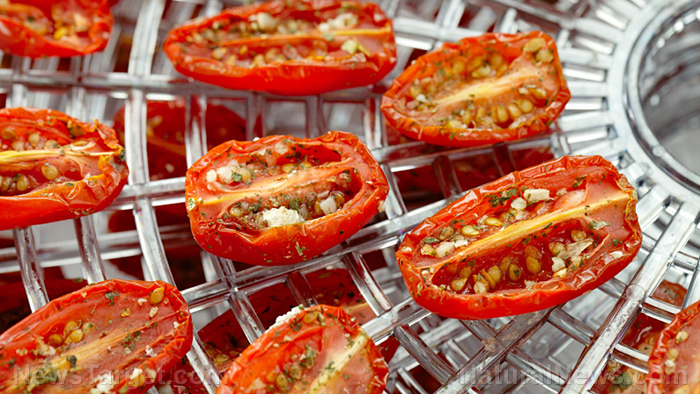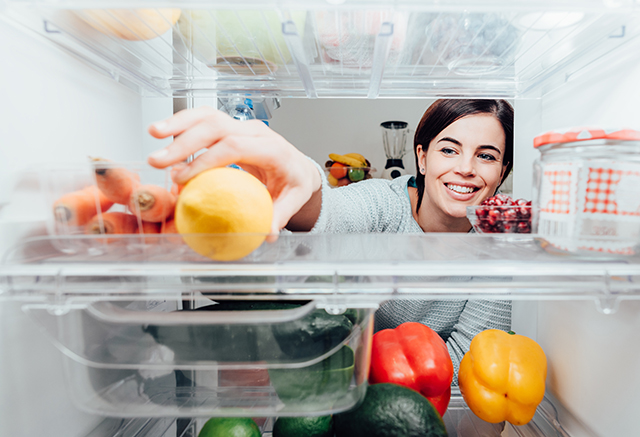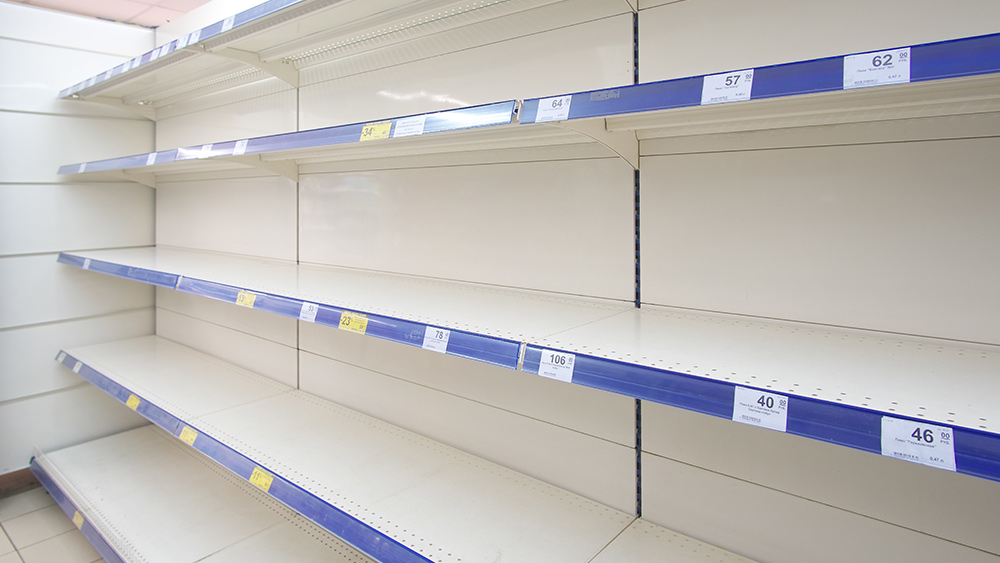Home gardening: Growing ripe, juicy tomatoes
06/17/2022 / By Zoey Sky

Fresh, tasty tomatoes are great in salads, sandwiches or salsa. But instead of buying tomatoes at the grocery store, save money by growing juicy tomatoes in your home garden.
Read on for tips that can improve your chance of growing healthy and delicious tomatoes this gardening season. (h/t to TheHomesteadingHippy.com)
Decide which tomato varieties to plant
There are different kinds of tomatoes, so make sure you choose the variety that best suits your needs before planting anything in your garden.
When deciding what kind of tomatoes to grow, know that they are divided into two large categories: Determinate and indeterminate tomatoes.
- Determinate tomatoes bloom and set fruit all at once and then decline. They don’t require staking or pruning for the most part.
- Indeterminate tomatoes will produce tomatoes all summer long and their flowers grow along with the vines instead of at the ends. Indeterminate tomatoes need support and pruning, but the extra work gives you a bigger harvest.
Next, you can choose between heirloom and hybrid tomatoes.
Most tomatoes grown today have been bred in some way. This means their reproduction and pollination have been controlled to encourage certain qualities.
Heirloom tomatoes are the purest form of tomatoes and they have been developed through open pollination. Meanwhile, hybrid tomatoes are developed via forced cross-pollination between two different varieties.
Hybrid tomatoes are rather disease-resistant, but heirloom tomatoes have some of the most unique and best flavors.
Common tomato varieties
Here are some of the most common types of tomatoes:
Beefsteak tomatoes
Beefsteak tomatoes are some of the largest tomatoes. They have meaty textures and an intense flavor.
Beefsteak tomatoes are available in black, pink, purple, red or yellow. They are best for burgers and sandwiches. You can also use beefsteak tomatoes for canning or sauces.
Cherry tomatoes
Cherry tomatoes may be the smallest, but they are also the sweetest of all tomatoes.
Cherry tomatoes can be red, green, yellow or black with a soft texture. Use cherry tomatoes to make salads, skewers and kebabs.
Plum tomatoes
Plum tomatoes are often used in premade sauces and tomato paste. Plum tomatoes are cylindrical and have minimal seeds.
Yellow tomatoes
Yellow tomatoes are generally less acidic and higher in folate. However, they are lower in vitamin C compared to traditional red tomatoes.
Be selective about tomato seedlings
Not all gardeners can direct sow tomato seeds into the ground unless you live in a growing zone where it is warm enough for this sowing method. With direct sowing, you don’t need to worry about purchasing or transplanting seedlings.
But if you don’t have any other option but to transplant seedlings, get healthy plants. If a plant is too tall, like it’s about to fall over, don’t get it. It’s leggy and will struggle to receive enough light.
A tall plant is already stressed and the additional stress from transplanting won’t be good for it. Look for a plant that is leafy, with a defined main stem and is around six inches tall.
Depending on how much space you have for your garden, you can either grow tomatoes in the ground or in containers.
Choose a bright and well-ventilated, airy location for your tomatoes. The tomato plants need at least 10 hours of full sun in the summer.
When planting tomatoes, leave enough room between the plants for adequate air circulation. If your chosen area is ideal, plant directly in your garden.
If space is an issue, grow tomatoes in containers. You can easily move buckets whenever and wherever you see fit, like when the weather shifts unexpectedly.
Container gardening also gives you more control over soil and moisture. You can grow your tomatoes in any kind of container, but it’s best to use something that’s at least 18 inches wide and deep so your plants have enough space to grow without getting rootbound.
Choose a container with lots of drainage holes. (Related: Home gardening tips: How to grow flowers and vegetables in bucket planters.)
Get ahead of the growing zone
Tomato plants take a long time to mature. If you live in a cold growing zone, like Zone 5 and cooler, it will be better to get a head start on the tomato growing season by starting seeds inside.
This means you need to start seeds in peat pots inside in January, February or March, depending on how soon you want to plant. It’s time to transplant once the soil temperatures have warmed up and there is no sign of frost.
Before transplanting, wait until the weather is warm and the daylight hours are long enough to support developing plants. The ground must be completely warm. Tomatoes are sensitive to soggy soil and they might become waterlogged in the early spring.
Don’t move plants directly outside in one go without hardening off seedlings.
Expose tomato plants to increasing amounts of outside conditions for about a week. Start with an hour the first day, then increase the time up to a full 24 hours by the last day. After this, your plants will be ready to transplant into the ground. Hardening off plants helps acclimate them to outdoor conditions.
Transplant on a cloudy day so that you don’t have to worry about the harsh sun scalding delicate plants.
If a frost or unexpected cold snap passes through after you’ve transplanted your seedlings, protect them with a row cover or light canvas but don’t suffocate the developing branches.
Plant deep for the best possible results
Burying the stem of the tomato plants allows the plant to sprout new roots, which is important for improved strength and vitality. Additionally, it provides better absorption of the nutrients so your tomato plants can grow faster and healthier.
Remove the bottom sets of leaves and bury the stem up to just below the bottom of the remaining leaves. Alternatively, you can plant tomato plants horizontally in a long trench with just the top leafy part exposed.
The plant will correct itself and start growing up instead of along the ground. This helps tomato plants establish the strongest root structure possible.
You also need to test the soil for the proper growth of tomato plants. You can either take a sample of the soil to a gardening or home improvement center that offers lab testing or buy a DIY pH level testing kit.
Once you find out your soil’s alkaline and acidity levels, add the right soil amendments to reach the recommended 6.0 to 6.8 pH for tomatoes. Adding compost, chicken manure or crushed egg shells can help balance some of the levels.
Leaving lots of space between separate tomato plants helps prevent the spread of fungal growth, which can be a problem if you water the plants at night or during a particularly rainy season.
Pull off suckers or the little offshoots of the main stem below your first fruit-producing branch.
More tips for healthy tomato plants
Don’t let tomato vines lay on the ground because this makes plants more susceptible to pests and diseases. Use a stake or cage to protect your crops.
When the plants are setting fruit and the first fruit of the season begins to appear, add organic compost to encourage new, healthy growth in tomato plants and a bigger harvest.
Scratch composts into the ground around the stem and trim some of the upper leaves on each plant. Pruning tomatoes helps encourage fresh growth.
Water deeply each week and let at least one inch of water soak into the soil. This is necessary for setting fruit and keeping the plant strong.
Plant new tomato plants three weeks after your original plants are planted so you won’t harvest and use your entire crop at once. This also means you can enjoy a fresh garden tomato harvest longer in the season.
Watch the video below for tips on how to grow tomato plants in a plastic hanging bottle.
This video is from the Backyard Farming channel on Brighteon.com.
More related stories:
Home gardening: 3 Benefits of crop rotation.
Home gardening 101: 5 Secrets for growing great tomatoes.
Urban gardening: 6 Vegetables to grow in your backyard.
Sources include:
Submit a correction >>
Tagged Under:
crops, green living, harvest, home gardening, homesteading, how-to, off grid, organic farming, preparedness, prepper, prepping, sustainable living, tips, tomatoes
This article may contain statements that reflect the opinion of the author
RECENT NEWS & ARTICLES
COPYRIGHT © 2017 PREPAREDNESS NEWS




















